VFS insignificantly enhanced water quality of effluent
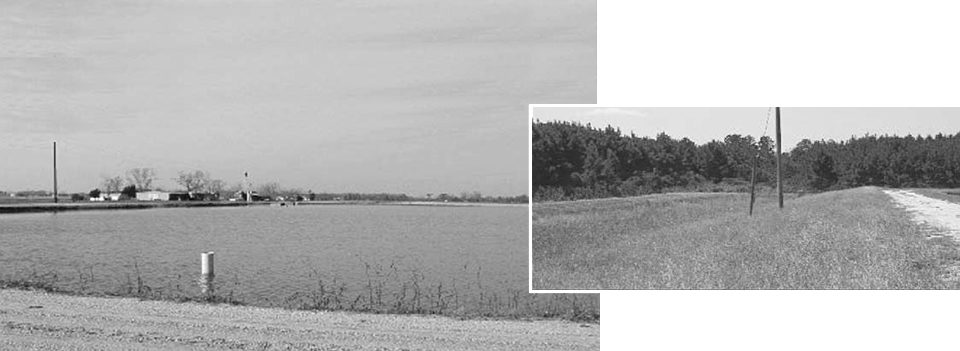
The characterization of aquaculture effluent is of increasing importance in developing best management practices (BMP) that reduce environmental impacts. To provide field data verifying the effectiveness of such practices and support specific BMP guidelines and application, the authors integrated a vegetated filter strip (VFS) into a commercial catfish pond in northwest Florida, USA.
VFS design
A 3.2-hectare channel catfish pond was designed to discharge stormwater overflow through a trickle-flow control device to a 6- x 150-meter VFS planted with Bahia grass, Paspalum sp. Runoff samples were collected by autosampler at the point of pond discharge into the VFS, at the end of the VFS, and manually at several points up to 150 meters from the pond discharge.
Samples were analyzed for nitrate, nitrite, ammonium, total carbon, total nitrogen, carbon:nitrogen ratio, total phosphorus, orthophosphate, pH, alkalinity, conductivity, total suspended solids, total dissolved solids, temperature, dissolved oxygen, and a variety of ions and metals. Composite soil samples were periodically collected at right angles to the water flow down the VFS.
Results
Analyses showed the VFS enhanced the water quality of the effluent, but not to a significant degree for several parameters. Reductions in total carbon and total nitrogen, and notable increases in dissolved oxygen were apparent downstream within the VFS.
Aeration from the discharge pipe elevated the dissolved oxygen of the pond overflow. The biological oxygen demand (BOD) of the effluent diminished with distance down the filter strip (Fig. 1). Thus, use of the strip improved dissolved oxygen levels as a consequence of lessened BOD. Typically, ammonium concentrations decreased along the VFS – another indication that it alleviated the most significant pollutant in aquaculture effluent (Fig. 2).
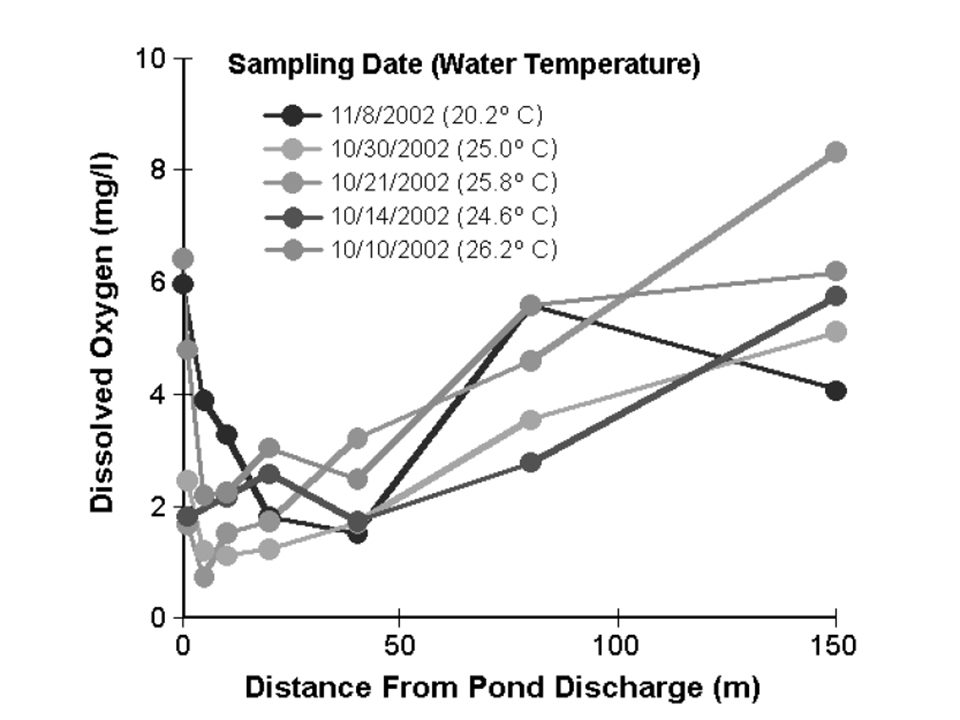
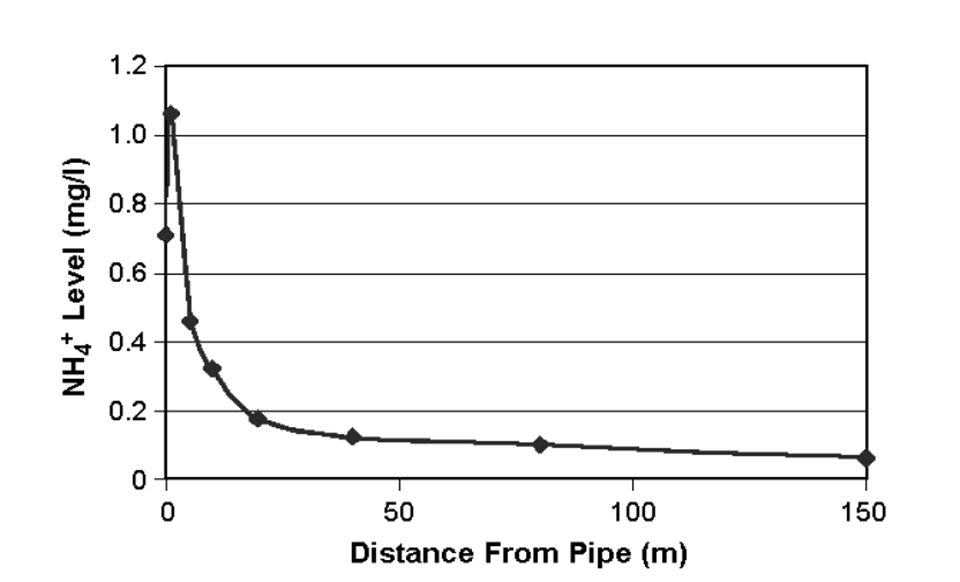
The efficacy of vegetative filter strips to attenuate nutrient loads depends on soil microbial communities, as they catalyze the biogeochemical cycling of nitrogen and other elements. The soil microbial communities within the VFS ecosystem should react to nitrogen balance. Different nitrogen-cycling guilds of microbes (e.g., nitrogen-fixing prokaryotes that use nitrate, nitrite, or ammonium as nitrogen sources), transform nitrogen pools and affect nitrogen bio-availability to plants.
The authors enumerated relevant functional categories of microorganisms in the soil along the VFS. The ammonium-utilizing microbe population densities decreased along the VFS as ammonium in the soil and water diminished along the strip. Although nitrogen-fixing prokaryote populations tended to increase along the VFS as ammonium concentrations decreased, nitrogen fixation was not detected by the acetylene reduction method.
Conclusion
Research validated the use of a vegetative filter strip in catfish aquaculture as an effective management practice for attenuating ammonium and total suspended solids, and improving dissolved oxygen in aquaculture runoff. Ammonium was removed as an exponential function of distance along the VFS from the discharge pipe.
Aeration at the point of discharge into the VFS temporarily elevated the dissolved oxygen of the overflow. An initial pronounced drop in dissolved oxygen was apparent in runoff collected over the first few meters of the VFS due to the high biological oxygen demand of the effluent. This trend was progressively reversed as the effluent progressed down the VFS. Thus, the VFS improved runoff water quality in that dissolved oxygen is raised as a consequence of lessened BOD.
(Editor’s Note: This article was originally published in the April 2004 print edition of the Global Aquaculture Advocate.)
Now that you've reached the end of the article ...
… please consider supporting GSA’s mission to advance responsible seafood practices through education, advocacy and third-party assurances. The Advocate aims to document the evolution of responsible seafood practices and share the expansive knowledge of our vast network of contributors.
By becoming a Global Seafood Alliance member, you’re ensuring that all of the pre-competitive work we do through member benefits, resources and events can continue. Individual membership costs just $50 a year.
Not a GSA member? Join us.
Authors
-
C.L. Kiely, M.S.
Center for Environmental Diagnostics and Bioremediation
University of West Florida
Pensacola, Florida 32514 USA -
R.A. Snyder, Ph.D.
Center for Environmental Diagnostics and Bioremediation
University of West Florida
Pensacola, Florida 32514 USA -
A.M. Lazur, Ph.D.
Center for Environmental Diagnostics and Bioremediation
University of West Florida
Pensacola, Florida 32514 USA -
J.E. Lepo, Ph.D.
Center for Environmental Diagnostics and Bioremediation
University of West Florida
Pensacola, Florida 32514 USA[117,100,101,46,102,119,117,64,111,112,101,108,106]
Tagged With
Related Posts
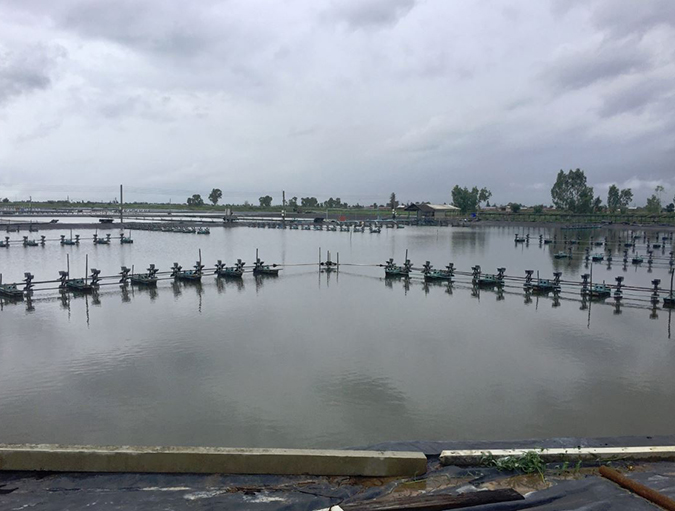
Health & Welfare
Aquamimicry: A revolutionary concept for shrimp farming
Aquamimicry simulates natural, estuarine production conditions by creating zooplankton blooms as supplemental nutrition to the cultured shrimp, and beneficial bacteria to maintain water quality. Better-quality shrimp can be produced at lower cost and in a more sustainable manner.

Responsibility
Examining copper use in aquaculture
Copper is used for control of the blue-green algae responsible for off-flavors in aquaculture animals, treating diseases and parasites, and avoiding cage net fouling. Although copper is an essential nutrient for plants and animals, an excess can negatively affect the environment and human health.
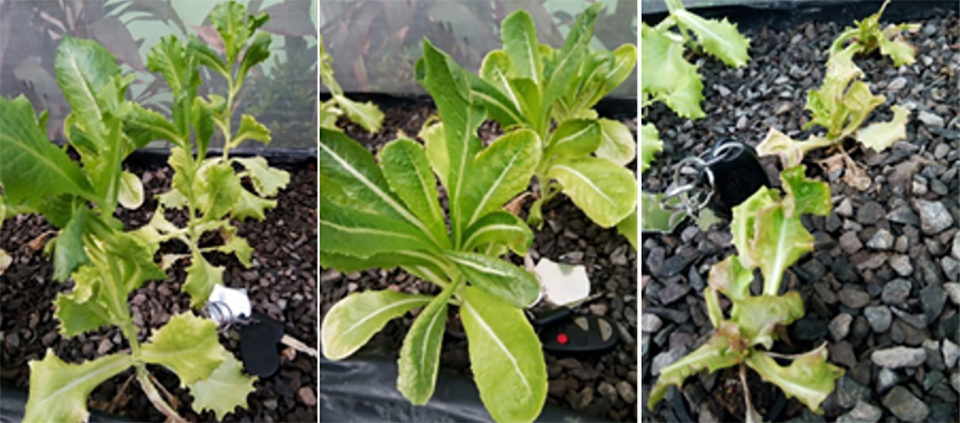
Innovation & Investment
Experimental aquaponics system in Costa Rica
This study evaluated the performance and production of channel catfish and freshwater prawns and three varieties of lettuce – American, Romaine and Rose – in a research aquaponics system.
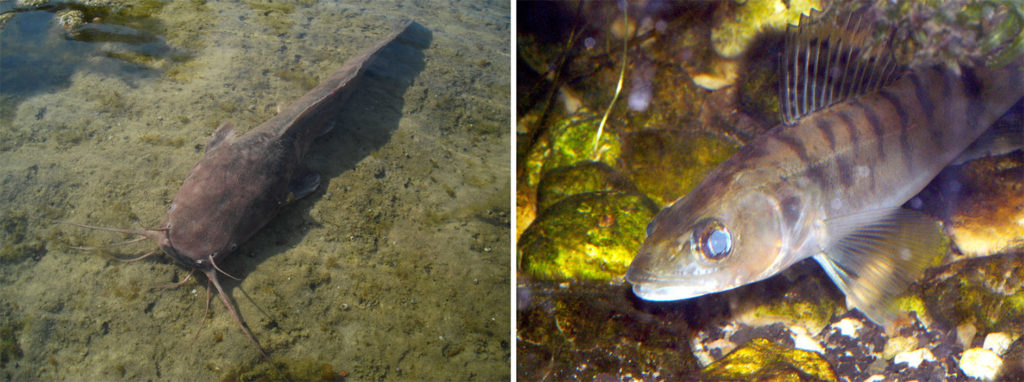
Responsibility
Integrated utilization of microalgae grown in aquaculture wastewater
A study shows that wastewater from recirculating aquaculture systems is suitable for microalgal cultivation and that sludge amendment to the wastewater increases production.


